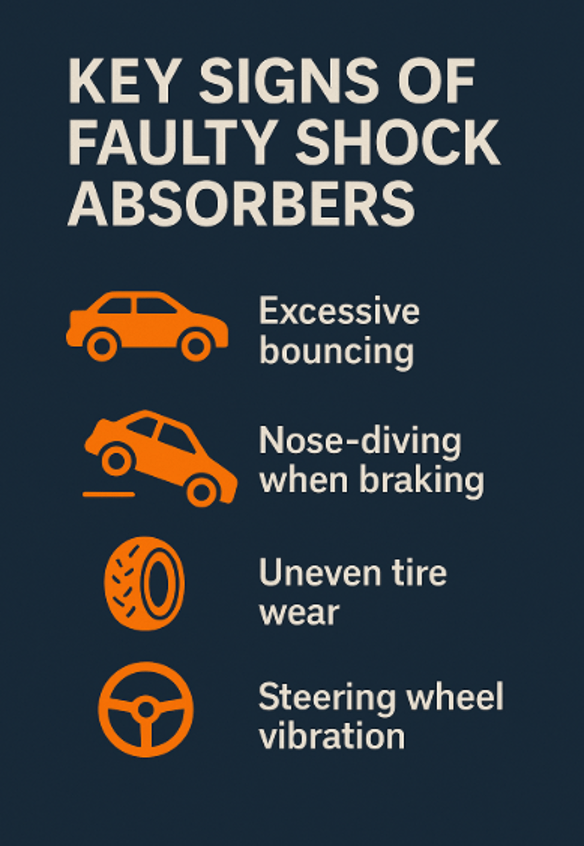Over many years, when car enthusiasts see a BMW, the first they say is, “That’s a performance car.” Yes, BMW has been known to be a luxury brand that delivers high-performance premium cars with incredible balance and outstanding driving dynamics, without compromising the prestige and sheer enjoyment of driving a “luxury” car.
However, even the “Ultimate Driving Machine” isn’t immune to weak points. Owners around the globe report recurring issues—ranging from oil leaks and engine overheating to suspension failures and electronic gremlins. This article drills into the most frequent problems across the 3-Series, 5-Series, and X-model lineups, examining how reliability shifts by generation and driving style, and offers expert guidance on managing early signs of, particularly, shock-absorber wear.
BMW Reliability Metrics
RepairPal gives BMW a 2.5/5.0 reliability score, placing it 30th of 32 brands, with an average annual repair cost of around $968. Owners of a BMW model are assumed to visit a repair at least 0.9 times per year, with a 15% chance of a severe repair.
The 3-Series scores about 65/100 on Warrantywise’s index, outperforming many mainstream rivals—but still trailing top luxury marques. Newer models with turbocharged engines definitely bring power gains but also heightened complexity in repairs, which further takes the maintenance and repair costs further high.
The Early N54/N55 engines used in most 2006–2015 BMW models suffered from high-pressure fuel pump failures and coolant leaks, while later B58 units (2016-on) improved reliability but introduced electronic turbo controls prone to sensor faults.
Engine and Oil-Related Complaints
Sadly, BMW models have had quite many engine and oil leak-related complaints from owners, and here are some of the common complaints.
1. Oil Leaks
Most of the N52/N54 six-cylinder engines experienced valve-cover gasket failure after about 80–100k kilometers. Also, it is reported that the oil filter housing gaskets on models with this engine tend to harden and crack, leading to visible puddles under the engine.
2. Overheating
Being one of the worst things any driver would want to experience on their vehicle, overheating is a serious concern for car buyers. For BMWs, especially in the 5-series E60 models, most owners reported the plastic thermostat housings and water pumps can fail prematurely at 60–90k km, resulting in coolant leaks and overheating. Radiator cracks and fan-clutch malfunctions are other reported faults too.
3. Shock Absorber Failures
Shock absorbers and struts are among the most critical—and costly—wear items on a BMW. The front/rear shocks on BMWs typically require replacement after about 60–80k km, especially under aggressive driving or poor road conditions. Some signs that your shock absorbers are about to fail include:
- Excessive bouncing after bumps
- Knocking or clunking noises over rough surfaces
- Uneven tire wear and reduced cornering precision
Recall Alerts: BMW issued recall 06V-277 to address lower rubber-mount failures for the rear shock absorbers—but that was in 2006, pretty long ago.
Average BMW Shock-Absorber Replacement Costs
|
Model |
Front Pair |
Rear Pair |
Labor Hours |
|
3-Series (E90) |
$600–$800 |
$550–$750 |
2.5 |
|
5-Series (F10) |
$700–$900 |
$650–$850 |
3.0 |
|
X5 (F15) |
$800–$1,000 |
$750–$950 |
3.5 |
4. Electronics and High-Tech Glitches
The reason why BMWs deliver absolutely thrilling driving dynamics is because of the advanced high-tech electrical components installed in them. But these electrical components are prone to failures:
- iDrive System: You may experience screen flickering, frozen menus, or complete system shutdown around 100k km on E90/E92 models.
- Sensor Failures: Mass-airflow sensors, throttle actuators, and turbo boost sensors can drift or fail, triggering limp mode.
- Battery and Charging: The AGM batteries on M-Sport packages often degrade faster, leading to start-stop system malfunctions.
BMW Common Problems by Series
- 3-Series (Sedan/Coupe): Frequent suspension wear.
- 5-Series (Executive Sedan): The heavier curb weight tends to lead to earlier suspension and brake component fatigue.
- X-Models (SUVs): Shock and bushing failures.
Generally, conservative drivers may see their shock-absorber life extend to 100k km, with fewer electronic faults, while performance enthusiasts may have an average of 60k km before the problems show up.
Action Plan for BMW Shock Absorber Issues

When you notice your shock absorber may have failed, here are some recommended actions to confirm your assertion.
- Visual Inspection: Look for oil leaks on the shock body and check for torn dust boots.
- Bounce Test: Press down on each corner—more than 2–3 bounces indicate worn shocks.
- Noise Diagnosis: Clunks or squeaks over bumps point to failing mounts or bearings.
Replacement Strategy:
Always replace the front pair or rear pair together to maintain balanced handling. Consider a full-set replacement if your current mileage is over 100k km or if all four shocks exhibit signs of wear. For instance, when it comes to the BMW 1 series shock absorber, many owners report a noticeable decline in ride comfort and steering precision as early as 70,000 kilometers—making timely replacement essential for maintaining handling dynamics and passenger safety.
Conclusion
BMW delivers unrivaled driving pleasure, but its hallmark complexity brings maintenance challenges. Of course, it’s still advisable to buy and drive a BMW, but be sure to do your due diligence research and buy one of the least problematic models.
Further Read: More information on the website - autodoc.co.uk




